
Bitcoin Security Tips to Protect Your Assets
To protect Bitcoin assets, individuals should choose the right wallet type, balancing convenience and security. Hot wallets are user-friendly but vulnerable to hacking, while cold wallets offer better protection by storing private keys offline. Utilizing strong, unique passwords and two-factor authentication is essential. Regularly update software and firmware to combat emerging threats. Additionally, recognizing phishing scams and diversifying wallet storage can enhance security. Exploring further can provide additional insights into effective protective measures.
Table of Contents
Key Takeaways
- Use cold wallets for long-term storage of Bitcoin to enhance security against online threats.
- Keep your recovery seed phrases in multiple secure, offline locations to prevent unauthorized access.
- Implement strong, unique passwords for all accounts related to your crypto assets, and update them regularly.
- Monitor your wallets frequently for any unauthorized transactions to detect potential security breaches early.
- Educate yourself on phishing scams and report suspicious activities to protect your assets from fraud.
Understanding Bitcoin Wallet Types
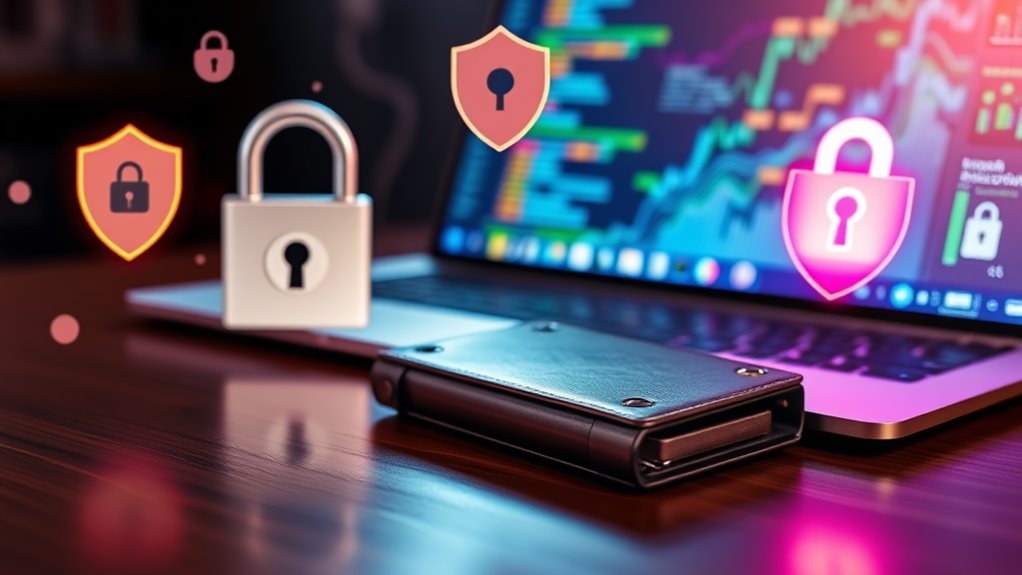
When exploring the world of Bitcoin, understanding the different types of wallets is fundamental for effective management and security of digital assets.
Bitcoin wallets are primarily classified into hot and cold wallets. Hot wallets, which are connected to the internet, offer convenience for daily transactions but are more susceptible to hacking. Examples include mobile and web-based wallets like Coinbase.
In contrast, cold wallets provide higher security by storing private keys offline, with hardware wallets such as Ledger and Trezor being popular choices. Choosing the right wallet can significantly impact the safety of your assets.
Safeguarding private keys remains essential, regardless of wallet type. Additional security measures, including multi-factor authentication, further enhance protection against unauthorized access and potential fraud, making informed choices critical for Bitcoin users.
Best Practices for Hardware Wallets
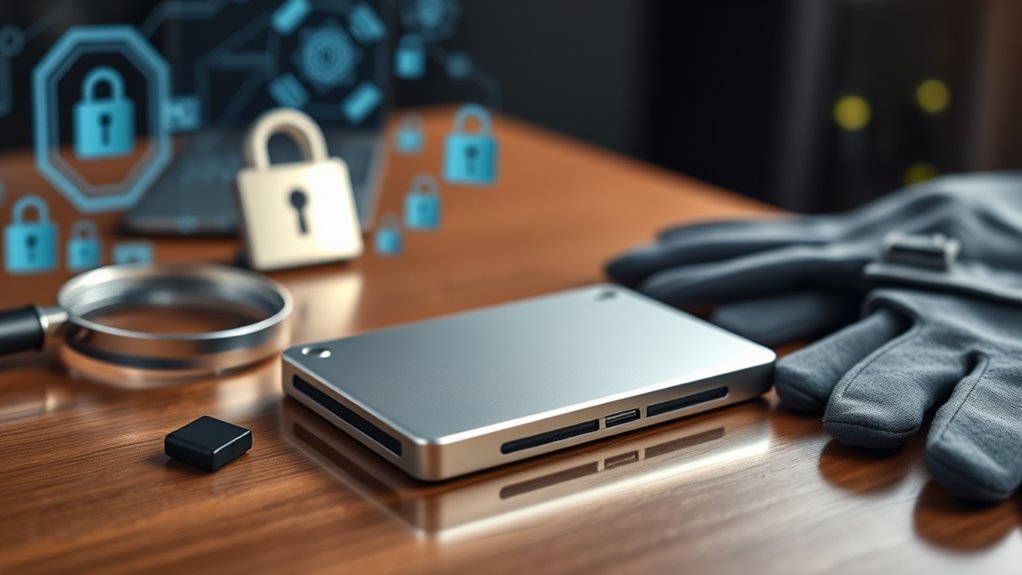
When selecting a hardware wallet, it is essential to contemplate both device selection criteria and secure key management practices.
Choosing a wallet from a reputable vendor with strong security features is vital for protecting assets. Additionally, managing the recovery seed phrase and setting up secure access controls can greatly enhance the security of the stored cryptocurrencies. Furthermore, opting for wallets that support secure wallet apps can provide an additional layer of protection against potential threats.
Device Selection Criteria
Selecting the right hardware wallet is crucial for ensuring the security of cryptocurrency holdings. When choosing a device, consider the security features it offers, such as offline storage to protect private keys from online threats.
Look for tamper-proof designs and secure element chips, which enhance the safety of stored cryptographic information. Additionally, customizable transaction approvals, such as multisignature options, provide extra layers of security.
It is also important for the wallet to support secure backup and recovery processes. Users should evaluate the wallet’s compatibility with various cryptocurrencies and operating systems, as well as its user interface for intuitive setup and transaction confirmation.
Furthermore, comparing wallets based on features, security, and usability can help users make informed decisions about their cryptocurrency storage solutions.
Finally, regular firmware updates and responsive customer support are critical for ongoing security and functionality.
Secure Key Management
Secure key management is a vital aspect of protecting cryptocurrency holdings, especially for users utilizing hardware wallets. To enhance security, users should keep their hardware wallets in secure, inaccessible locations, such as a safe or vault.
It is important to protect seed phrases and backups from theft and loss, storing them in multiple offline locations. Avoid sharing recovery phrases with anyone to maintain security, and regularly verify that backups can restore wallet funds correctly. Additionally, employing multisignature wallets can provide extra security by requiring multiple keys for transaction authorization. Users should also keep their software updated and monitor their wallets for unauthorized transactions to guarantee their assets remain secure against both online threats and physical risks. Moreover, understanding best practices for secure storage can significantly reduce the likelihood of losing access to your funds.
The Importance of Strong Passwords
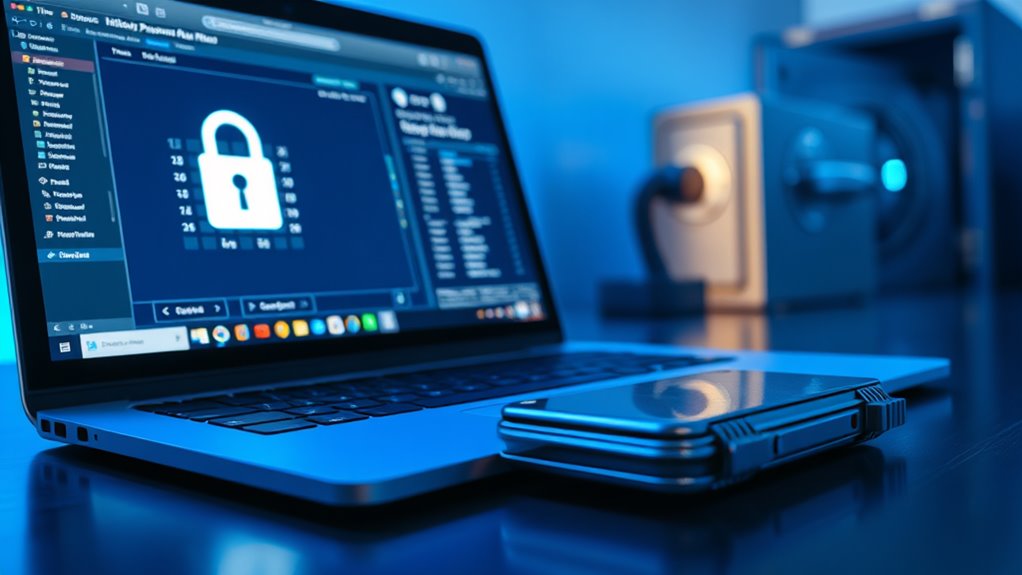
Strong passwords serve as the foundational defense in protecting cryptocurrency assets from unauthorized access. They act as the primary barrier against potential threats, making their importance undeniable.
To create effective passwords, individuals should consider the following tips:
- Complexity Matters: Combine uppercase and lowercase letters, numbers, and special characters.
- Length is Vital: Aim for passwords that are at least 12 characters long.
- Avoid Guessable Information: Refrain from using personal details or common words.
Employing these strategies not only strengthens account security but also minimizes the risk of theft and financial loss. Additionally, using unique passwords for different accounts is essential, as a single breach can compromise multiple assets. Regular updates to passwords further enhance security measures. Furthermore, choosing exchanges that prioritize secure and regulated environments can provide an extra layer of protection for your assets.
Utilizing Two-Factor Authentication
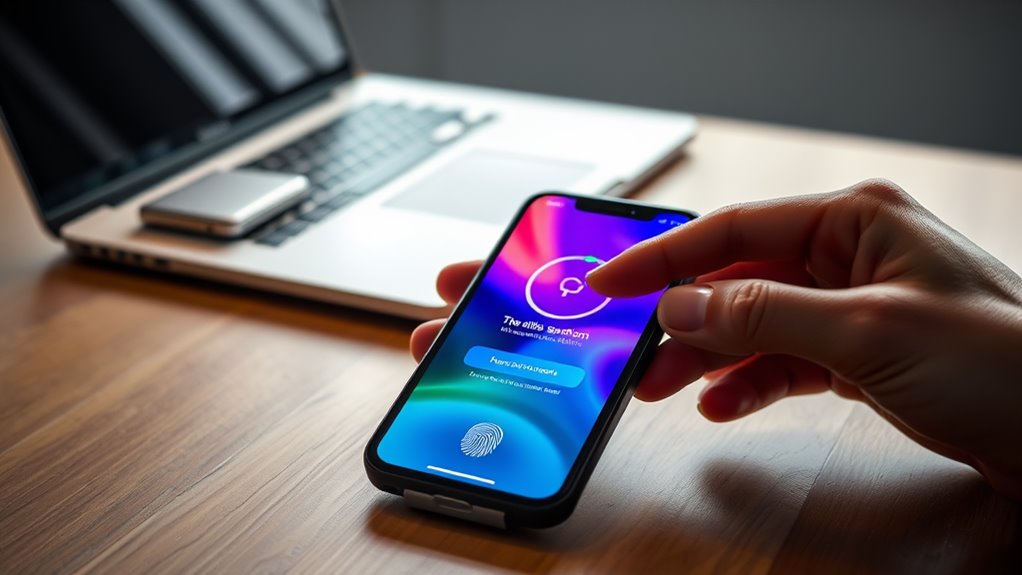
Passwords form a critical line of defense against unauthorized access, but relying solely on them can leave accounts vulnerable to attacks.
To enhance security, utilizing Two-Factor Authentication (2FA) is essential. It adds a second layer of protection, requiring users to verify their identity through a secondary method. Common options include SMS codes, mobile authenticator apps, and hardware tokens. Each method has its benefits; for example, authenticator apps are generally more secure than SMS due to potential interception risks.
Implementing 2FA is straightforward: users access security settings, select their preferred method, and follow prompts to complete setup.
Recognizing Phishing Scams

Recognizing phishing scams is essential for anyone involved in cryptocurrency.
Common techniques include emails with urgent requests, misleading links, and impersonation of reputable figures.
Identifying Phishing Emails
How can individuals effectively identify phishing emails and protect themselves from scams?
Recognizing the signs of phishing is essential for maintaining security. Here are three key indicators to watch for:
- Generic Greetings: Phishing emails often use non-specific salutations rather than addressing the recipient by name.
- Urgency and Threats: These messages may create a false sense of urgency, claiming account suspension or billing issues to prompt immediate action.
- Inconsistent Sender Addresses: Check the sender’s email address carefully, as slight variations can indicate an attempt to impersonate a legitimate source.
Common Scam Techniques
In the world of cryptocurrency, understanding common scam techniques is vital for anyone looking to protect their assets.
Phishing scams are prevalent, with various forms including phishing websites that mimic legitimate platforms to steal private keys. Scammers may impersonate celebrities or influencers to gain trust, while romance fraud exploits emotional connections to solicit funds.
Investment scams promise unrealistic returns, drawing in unsuspecting victims. Additionally, scammers often use clever wordplay in domain names to create fake websites.
Malicious smart contracts can drain wallets by executing transactions without the user’s awareness. These scams frequently gain traction through social media and fake giveaways, targeting inexperienced users.
Awareness of these techniques is essential for safeguarding cryptocurrency investments, especially during times of market volatility when emotional trading traps can lead to poor decision-making.
Reporting Phishing Attempts
Phishing attempts are a serious threat in the cryptocurrency world, and understanding how to report them is essential for protecting oneself and others.
Recognizing and reporting these scams can help prevent further incidents. Here are key steps to take:
- Report to Platforms: Inform cryptocurrency platforms, like Coinbase, about phishing sites to help shut them down.
- Document Evidence: For email scams, provide detailed information, such as email headers. For text scams, take screenshots and report suspicious messages to your mobile carrier by sending them to 7726 (SPAM).
- Notify Authorities: Contact the FBI’s Internet Crime Complaint Center (IC3) to report any phishing or investment scams related to cryptocurrency.
Taking these actions helps create a safer online environment for all users.
Safe Management of Private Keys
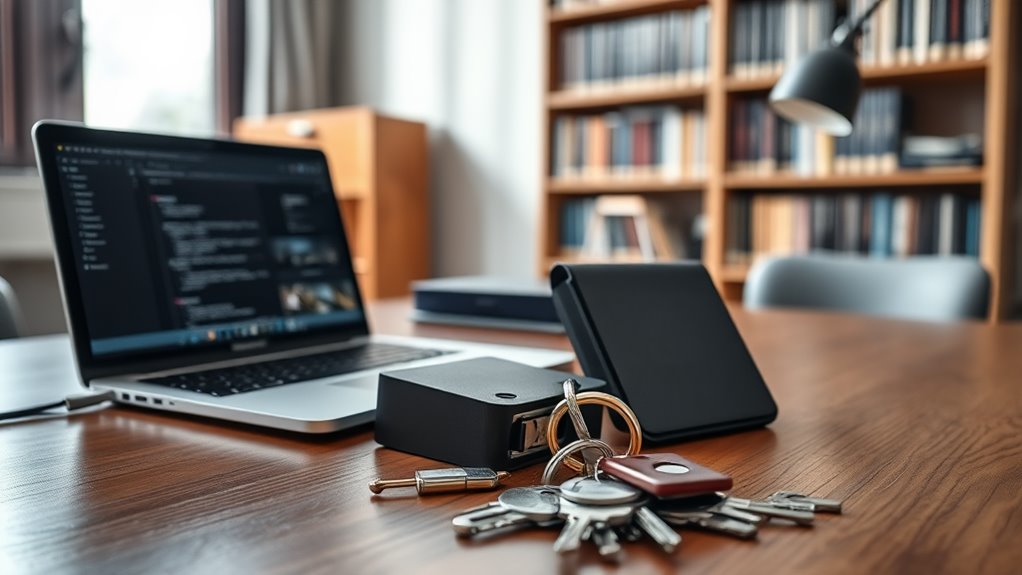
The safe management of private keys is essential for protecting cryptocurrency assets from theft and unauthorized access. Individuals should store private keys in secure locations, such as safes or vaults, and avoid easily accessible areas. Encrypted storage solutions can enhance security for digital backups. Manual backups using recovery phrases are critical, and it is recommended to store seed phrases securely.
| Key Management Tip | Description |
|---|---|
| Secure Storage | Use safes or vaults for physical keys and encrypted solutions for digital keys. |
| Backup Procedures | Create manual backups and check their integrity regularly. |
| Access Controls | Limit device access and disable screenshot functions. |
| Education and Awareness | Understand risks and promote best practices. |
Implementing these strategies is essential for safeguarding private keys.
Regular Software and Firmware Updates
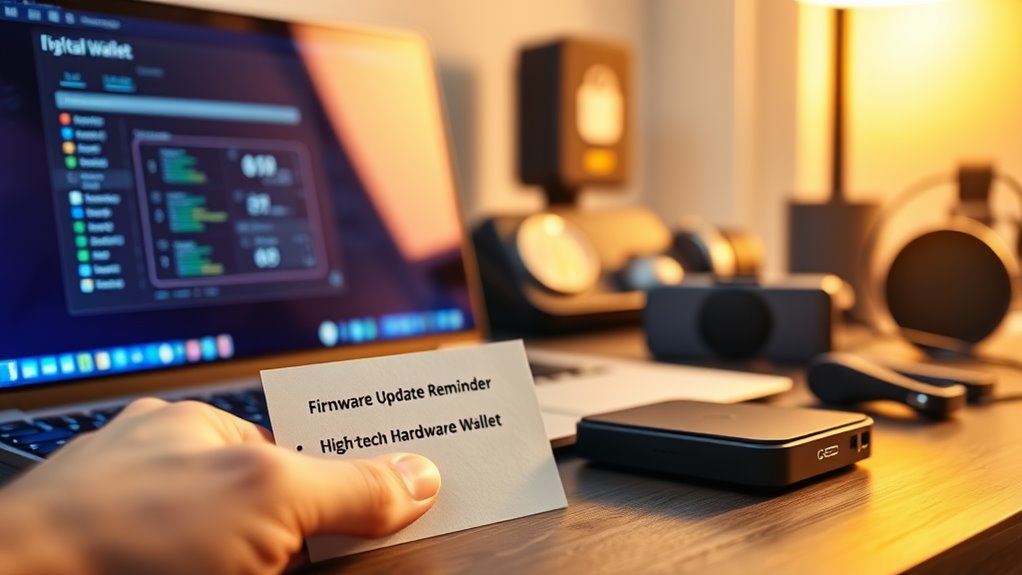
Regular software and firmware updates play an essential role in maintaining security within the cryptocurrency ecosystem. These updates address known vulnerabilities, ensuring that systems remain resilient against potential threats from hackers.
Additionally, implementing automated update settings can streamline the process, but users must approach them with caution to maintain control over their security measures.
Importance of Updates
Maintaining up-to-date software and firmware is essential for securing Bitcoin assets against evolving threats. Regular updates provide several important benefits that enhance security and performance.
- Enhanced Security Features: Updates often introduce new mechanisms to protect against emerging threats.
- Bug Fixes: They resolve software bugs, leading to smoother operations and fewer crashes.
- New Feature Integration: Updates may include support for new cryptocurrencies and features, keeping users current with technological advancements.
Neglecting updates can expose users to security vulnerabilities and compatibility issues, ultimately risking their data and funds.
Additionally, keeping software current is vital for understanding Bitcoin and its underlying technology.
Consequently, ensuring that software and firmware are regularly updated is a critical practice in safeguarding cryptocurrency assets.
Vulnerability Patch Management
Effective vulnerability patch management is a fundamental aspect of securing Bitcoin and other cryptocurrencies. This process involves regularly updating software and firmware to address Common Vulnerabilities and Exposures (CVEs). Timely remediation of these vulnerabilities is vital to prevent exploitation, as demonstrated by past incidents like the Bitcoin inflation bug.
Organizations often face challenges due to the large number of potential vulnerabilities; consequently, prioritizing which issues to tackle first is essential. Coordinating with ecosystem stakeholders, such as miners and exchanges, can guarantee swift updates and effective communication.
Additionally, conducting post-patch disclosures helps the community understand the fixes implemented. Regular assessments of security posture reinforce the importance of maintaining updated protections against emerging threats, thereby safeguarding digital assets. Furthermore, staying informed about U.S. regulations can help organizations align their security practices with legal requirements.
Automated Update Settings
Guaranteeing that software and firmware updates occur automatically is a crucial aspect of maintaining security in the cryptocurrency landscape.
Automated updates protect against known vulnerabilities by applying security patches and enhancements. They also improve user experience through new features, while minimizing the risk of exploitation by hackers.
Here are three best practices for managing automated updates:
- Enable automatic updates for both operating systems and cryptocurrency wallets to guarantee timely security measures.
- Download updates only from official sources to reduce the risk of malware.
- Regularly monitor device performance post-update to identify any issues early.
Diversifying Your Wallets

As individuals navigate the world of cryptocurrency, diversifying their wallets is an essential strategy for enhancing security and managing risk. This approach involves using various wallet types and applying geographical and sector-specific strategies. Additionally, understanding how to create and secure a wallet can significantly reduce the likelihood of losing assets to theft or fraud.
| Wallet Type | Security Level | Transaction Use |
|---|---|---|
| Software Wallets | Moderate | Regular transactions |
| Hardware Wallets | High | Long-term storage |
| Mobile Wallets | Low to Moderate | Quick transactions |
| Paper Wallets | Very High | Secure long-term storage |
| Web Wallets | Low | Easy access |
Implementing Incident Response Plans

Implementing an incident response plan is essential for organizations seeking to mitigate the risks associated with cybersecurity threats. A well-structured plan helps prepare for potential incidents and guarantees a prompt and effective response.
A robust incident response plan is crucial for organizations to effectively address cybersecurity threats and ensure swift action during crises.
Key components of such a plan include:
- Define Purpose and Scope: Establish clear objectives and identify personnel responsible for managing incidents.
- Incident Response Process: Outline steps for detecting, containing, and recovering from incidents.
- Post-Incident Review: Create a process to review incidents and refine the response plan based on lessons learned.
Staying Informed Through Educational Resources

In an ever-evolving digital landscape, staying informed about cryptocurrency security is essential for anyone involved in the space. Understanding blockchain technology lays the foundation for grasping security measures.
Knowledge of various wallet types, such as hot and cold wallets, is crucial for selecting secure storage options. Additionally, recognizing common security risks, like phishing and exchange hacks, helps in safeguarding assets.
Utilizing online educational platforms, such as Binance Academy and MIT OpenCourseWare, provides structured courses and resources for self-paced learning. Engaging with specialized communities, through forums and social media, enables individuals to exchange insights and stay updated on emerging threats. Additionally, leveraging real-time BTC analysis tools can enhance one’s understanding of market trends and security vulnerabilities.
Continuous education fosters a proactive approach, ensuring individuals remain equipped to navigate the complexities of cryptocurrency security.
Frequently Asked Questions
How Can I Recover Lost Access to My Bitcoin Wallet?
To recover lost access to a Bitcoin wallet, one should utilize seed phrases, private keys, and professional recovery services, while also ensuring secure storage of recovery information and regularly backing up wallet data to prevent future losses.
What Should I Do if My Hardware Wallet Is Damaged?
In the unfortunate event of a hardware wallet’s misfortune, one should seek solace in recovery options. Consulting the manufacturer for a replacement, utilizing seed phrases, and ensuring device security remains essential for future peace of mind.
Are There Any Bitcoin Security Apps Available?
Numerous Bitcoin security apps exist, featuring advanced functionalities like encryption, biometric authentication, and multi-signature wallets. These applications aim to enhance asset protection and facilitate secure transactions, ensuring users can manage their digital currencies safely.
How Do I Securely Dispose of Old Hardware Wallets?
To securely dispose of old hardware wallets, one must physically destroy the device, guarantee complete data erasure, back up the seed phrase in multiple secure locations, and follow local electronic waste disposal regulations.
Can I Use the Same Password for Multiple Wallets?
Using the same password for multiple wallets poses perilous problems. Password predicaments can lead to pervasive vulnerabilities, risking all accounts. Practicing prudent password policies, like unique and complex passwords, promotes protection and peace of mind.
Conclusion
To sum up, safeguarding Bitcoin assets is akin to fortifying a castle. Just as a fortress requires strong walls, vigilant guards, and regular maintenance to withstand attacks, so too must Bitcoin holders adopt robust security measures. By understanding wallet types, using hardware solutions, and staying informed about threats, individuals can effectively protect their digital wealth. Like a well-prepared kingdom, those who prioritize security can enjoy peace of mind in the ever-evolving landscape of cryptocurrency.




